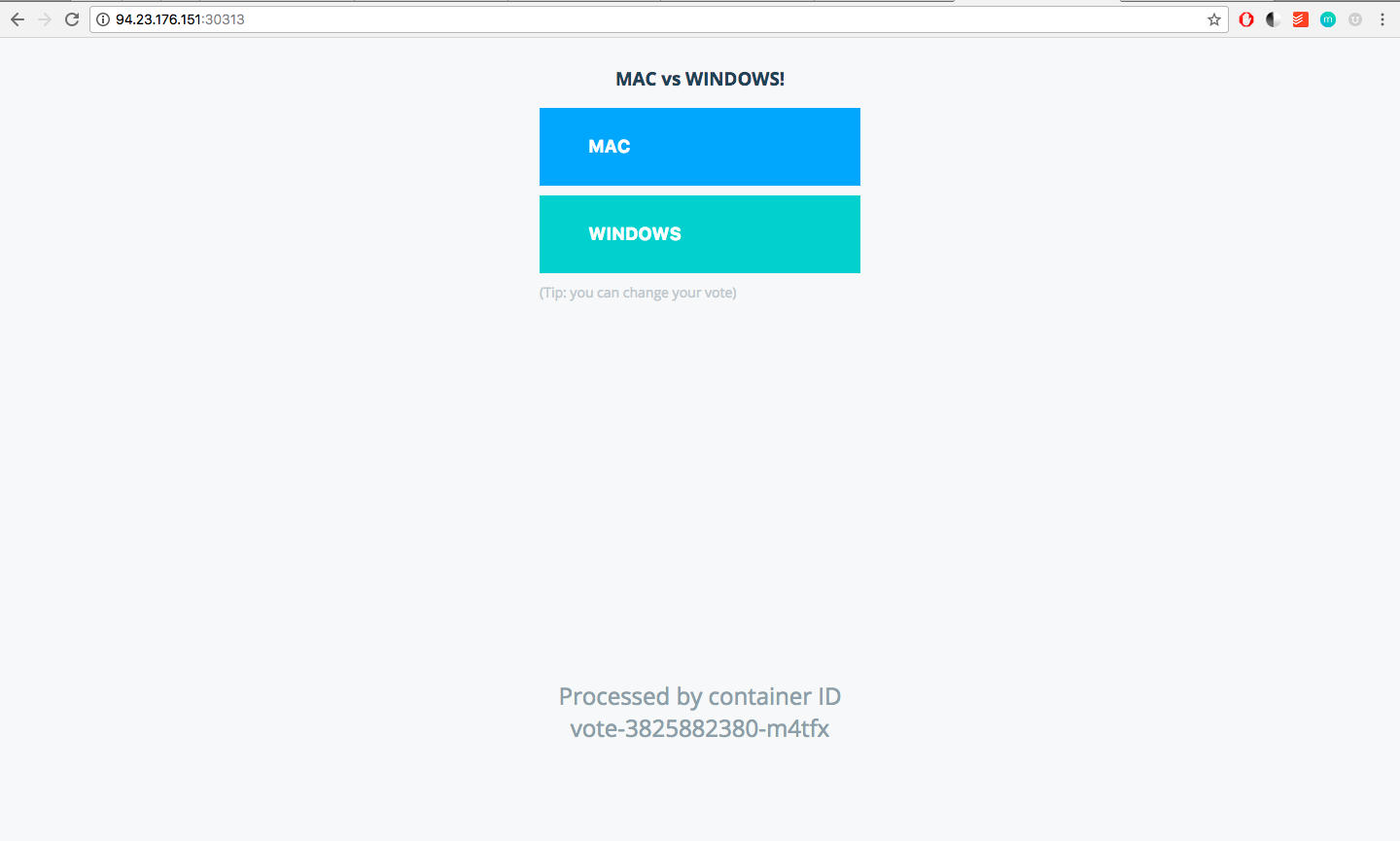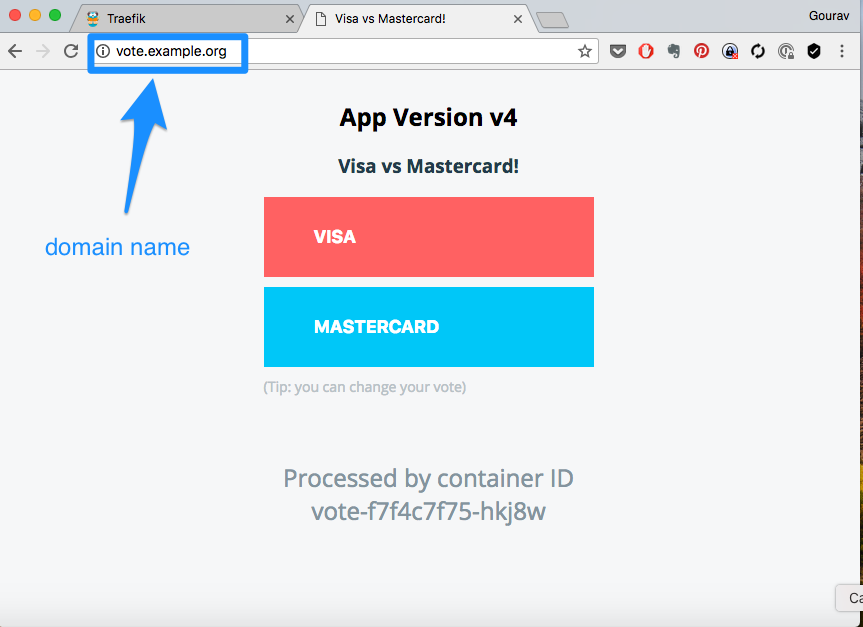Configurations Management with ConfigMaps and Secrets
Configmap is one of the ways to provide configurations to your application.
Injecting env variables with configmaps
Create our configmap for vote app
file: projects/instavote/dev/vote-cm.yaml
apiVersion: v1
kind: ConfigMap
metadata:
name: vote
namespace: instavote
data:
OPTION_A: Visa
OPTION_B: Mastercard
In the above given configmap, we define two environment variables,
- OPTION_A=EMACS
- OPTION_B=VI
Lets create the configmap object
kubectl get cm
kubectl apply -f vote-cm.yaml
kubectl get cm
kubectl describe cm vote
In order to use this configmap in the deployment, we need to reference it from the deployment file.
Check the deployment file for vote add for the following block.
file: vote-deploy.yaml
...
spec:
containers:
- image: schoolofdevops/vote
imagePullPolicy: Always
name: vote
envFrom:
- configMapRef:
name: vote
ports:
- containerPort: 80
protocol: TCP
restartPolicy: Always
So when you create your deployment, these configurations will be made available to your application. In this example, the values defined in the configmap (Visa and Mastercard) will override the default values(CATS and DOGS) present in your source code.
kubectl apply -f vote-deploy.yaml
Watch the monitoring screen for deployment in progress.
kubectl get deploy --show-labels
kubectl get rs --show-labels
kubectl rollout status deploy/vote

Note: Automatic Updation of deployments on ConfigMap Updates
Currently, updating configMap does not ensure a new rollout of a deployment. What this means is even after updading configMaps, pods will not immediately reflect the changes.
There is a feature request for this https://github.com/kubernetes/kubernetes/issues/22368
Currently, this can be done by using immutable configMaps.
- Create a configMaps and apply it with deployment.
- To update, create a new configMaps and do not update the previous one. Treat it as immutable.
- Update deployment spec to use the new version of the configMaps. This will ensure immediate update.
Mounting Files with ConfigMap Volume Type
If you want to make files e.g. configuration files available inside the container, you could add it to the ConfigMap, reference it as a volume in a pod and then finally mount it inside a container. Lets add a couple of config files for the vote app this way.
Begin modifying the ConfigMap for vote app with the content of the config files as:
apiVersion: v1
kind: ConfigMap
metadata:
name: vote
namespace: instavote
data:
OPTION_A: Visa
OPTION_B: Mastercard
development_config.py: |
class DevelopmentConfig:
DEBUG = True
TESTING = False
SECRET_KEY = 'development-key'
SQLALCHEMY_DATABASE_URI = 'sqlite:///development.db'
SQLALCHEMY_TRACK_MODIFICATIONS = True
SQLALCHEMY_ECHO = True
production_config.py: |
class ProductionConfig:
DEBUG = False
TESTING = False
SECRET_KEY = 'production-secret-key'
SQLALCHEMY_DATABASE_URI = 'postgresql://user:password@localhost/production'
SQLALCHEMY_TRACK_MODIFICATIONS = False
SQLALCHEMY_ECHO = False
where, development_config.py and production_config.py keys contain the entire configuration file content within this config map.
Apply and validate with,
kubectl apply -f vote-cm.yaml
kubectl describe cm vote
Now, to mount it as a volume, modify vote-deploy.yaml and add the spec.volumes and spec.container.volumeMount using the code reference below:
spec:
containers:
- image: schoolofdevops/vote:v1
name: vote
...
...
volumeMounts:
- name: config
mountPath: "/app/config"
readOnly: true
volumes:
- name: config
configMap:
name: vote
items:
- key: "development_config.py"
path: "development_config.py"
- key: "production_config.py"
path: "production_config.py"
optional: true
now apply the changes as
kubectl apply -f vote-deploy.yaml
To validate exec into one of the pods and list the files
kubectl exec -it vote-xxxx-yyyy sh
cd /app/config
ls
cat development_config.py
[sample output]
/app/config # ls
development_config.py production_config.py
/app/config # cat development_config.py
class DevelopmentConfig:
DEBUG = True
TESTING = False
SECRET_KEY = 'development-key'
SQLALCHEMY_DATABASE_URI = 'sqlite:///development.db'
SQLALCHEMY_TRACK_MODIFICATIONS = True
SQLALCHEMY_ECHO = True
This validates that the configuration files were created using ConfigMap and made available as a mount path inside the container.
Enabling HTTP Authentication for Nginx Ingress with Secrets
In this part of the lab, you will
- Create a secret with an existing file
- Modify a ingress rule to use that secret via annotations
- Validate if traefik, the ingress controller, automatically picks up the configurations and enables http auth s
Lets create htpasswd spec as Secret
apt install -yq apache2-utils
htpasswd -c auth devops
Or use Online htpasswd generator to generate a htpasswd spec. if you use the online generator, copy the contents to a file by name auth in the current directory.
Then generate the secret as,
kubectl create secret generic basic-auth --from-file auth
kubectl get secret
kubectl describe secret basic-auth
And then add annotations to the ingress object so that it is read by the ingress controller to update configurations. Reference Nginx Ingress Page to learn more.
file: vote-ing.yaml
---
apiVersion: networking.k8s.io/v1
kind: Ingress
metadata:
name: web
namespace: instavote
annotations:
nginx.ingress.kubernetes.io/auth-type: basic
nginx.ingress.kubernetes.io/auth-secret: basic-auth
# message to display with an appropriate context why the authentication is required
nginx.ingress.kubernetes.io/auth-realm: 'Authentication Required - Vote App'
spec:
ingressClassName: nginx
rules:
- host: vote.example.com
http:
paths:
- path: /
pathType: Prefix
backend:
service:
name: vote
port:
number: 80
- host: result.example.com
http:
paths:
- path: /
pathType: Prefix
backend:
service:
name: result
port:
number: 80
where,
- nginx.ingress.kubernetes.io/auth-type: "basic" defines authentication type that needs to be added.
- nginx.ingress.kubernetes.io/auth-secre: "basic-auth" refers to the secret created earlier.
apply
kubectl apply -f vote-ing.yaml
kubectl get ing/vote -o yaml
Observe the annotations field. No sooner than you apply this spec, ingress controller reads the event and a basic http authentication is set with the secret you added.
+----------+
+--update----> | nginx |
| | configs |
| +----------+
+----+----+--+ ^
| ingress | :
| controller | :
+----+-------+ :
| +-----+-------+
+---watch----> | ingress | <------- user
| annotations |
+-------------+

imagePullSecrets with Private Repository
Create a private repository from DockerHub as

docker image pull nginx:alpine
docker image tag nginx:alpine xxxx/nginxpvt:alpine
docker login
docker image push xxxx/nginxpvt:alpine
where replace xxxx with actual dockerhub username.
Generate a deployment manifest as
kubectl create deployment nginxpvt --image=xxxx/nginxpvt:alpine --replicas=1 --dry-run=client -o yaml | tee nginxpvt-deploy.yaml
apply this manifest and list the pods
kubectl apply -f nginxpvt-deploy.yaml
kubectl get pods
You will see the pod in error state. e.g.
NAME READY STATUS RESTARTS AGE
nginxpvt-79f8998f6c-9tvsg 0/1 ErrImagePull 0 4s
and describing the pod will show you that there is issue pulling the image from a private repository
Warning Failed 21s (x2 over 36s) kubelet Failed to pull image "initcron/nginxpvt:alpine": failed to pull and unpack image "docker.io/initcron/nginxpvt:alpine": failed to resolve reference "docker.io/initcron/nginxpvt:alpine": pull access denied, repository does not exist or may require authorization: server message: insufficient_scope: authorization failed
Warning Failed 21s (x2 over 36s) kubelet Error: ErrImagePull
You could generate a secret with your registry credentials as,
kubectl create secret docker-registry dhcreds \
--docker-server=https://index.docker.io/v1/ \
--docker-username=xxxx \
--docker-password=yyyy \
--docker-email=abc@pqr
where, * xxxx : replace with actual registry username * yyyy : replace with actual password * abc@pqr : your registered email on the registry * https://index.docker.io/v1/ : can be changed to your private registry uri
kubectl describe secret dhcreds
Update nginxpvt-deploy.yaml with the imagePullSecrets as,
spec:
containers:
- image: initcron/nginxpvt:alpine
name: nginxpvt
resources: {}
imagePullSecrets:
- name: dhcreds
and apply as
kubectl apply -f nginxpvt-deploy.yaml
kubectl get pods
This time you shall see the pod running.
once done, you could clean up with
kubectl delete deploy nginxpvt
kubectl delete secret dhcreds